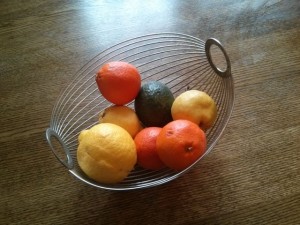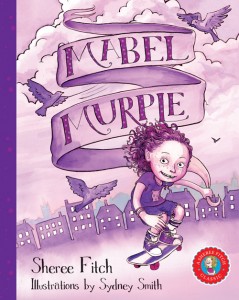March 23, 2015
Where I Find the Time to Read
 I read a lot. I read for a living, and I read to save my life, and, “Where do you find the time to read?” is a question that continues to baffle me. It’s like being asked where I find the air to breathe. The time, like the air, is out there in abundance, and having children hasn’t changed that. It just means I have to be creative in finding a way to make that time my own.
I read a lot. I read for a living, and I read to save my life, and, “Where do you find the time to read?” is a question that continues to baffle me. It’s like being asked where I find the air to breathe. The time, like the air, is out there in abundance, and having children hasn’t changed that. It just means I have to be creative in finding a way to make that time my own.
The following is a list of ordinary occurrences disguising excellent opportunities to steal a moment with a book.
- Extended Breastfeeding: Of the many benefits of breastfeeding, the time to read in is paramount. Once you’ve mastered holding a book open with one hand, it’s effortless, and oh so efficient—nourish a baby and your mind in a single shot. When my first daughter finally weaned at age 2 ½, I so mourned the loss of reading time that I had to have another baby.
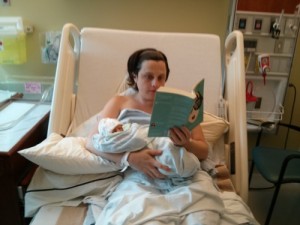 Before Bed: Every night, there is a window of sometimes up to ten minutes between the moment my head hits the pillow and when the baby awakes, and so I read then. And when the baby does awake, I breastfeed her. (See previous point.)
Before Bed: Every night, there is a window of sometimes up to ten minutes between the moment my head hits the pillow and when the baby awakes, and so I read then. And when the baby does awake, I breastfeed her. (See previous point.)
- Weekend lie-ins: Obviously, I don’t get out of bed in the mornings. Would you? On Saturday and Sunday mornings, there is always time to get a chapter in before I return to the vertical life, and if I stay in bed long enough, somebody probably will bring me a cup of tea. And then I don’t have to get up until I’ve drunk it.
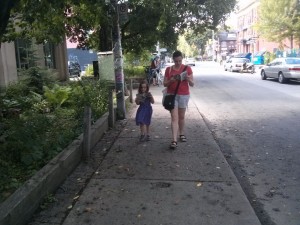 Walking: Walking while reading is walking the one risky behaviour I indulge in on a regular basis. Doing it while pushing a stroller is even more reckless, I realize, but sometimes one has to live on the edge. Also, I could make it to kindergarten and back with my eyes shut, so there’s no harm in doing with text in front of my face.
Walking: Walking while reading is walking the one risky behaviour I indulge in on a regular basis. Doing it while pushing a stroller is even more reckless, I realize, but sometimes one has to live on the edge. Also, I could make it to kindergarten and back with my eyes shut, so there’s no harm in doing with text in front of my face.
- At the playground: I will argue that reading at the playground is not entirely the opposite of being present for my children, mostly because there are only so many mud-pies I can pretend to gleefully devour. Also, every time they look up at the bench and see me reading there, I’m increasing their own chances of being readers by setting a good example. Everybody wins.
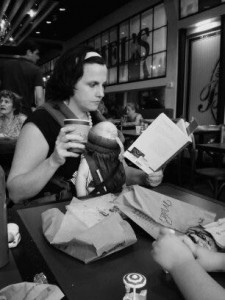 During interruptions: Basically, I find the time to read by always having a book in my bag. Sometimes two. And this means that when my husband takes the kids to the bathroom after a restaurant meal, I can finish a chapter along with the dregs of my tea.
During interruptions: Basically, I find the time to read by always having a book in my bag. Sometimes two. And this means that when my husband takes the kids to the bathroom after a restaurant meal, I can finish a chapter along with the dregs of my tea.
- Sitting alone in restaurants by myself: And other times, I forfeit the husband and kids altogether, and take myself out for a chai latte and oversized cookie, or even an entire lunch, and read the entire time. Cultivate your own company, is what I mean, and you will get so much reading done.
- In waiting rooms: As a parent with a book in her bag, there is nothing more luxurious than having to wait for appointments while the children are asleep in their strollers or in the care of somebody else. I’ve spent some of the best afternoons of my life in recent years reading for solid blocks of time at the passport office, my doctor’s, or the dentist.
- While flossing: Regarding the dentist, I have never before been so attentive to dental hygiene. I’ve become a vigilant flosser since I learned to floss and read, which is a skill involving holding open a book with my feet. I do this daily. For ten to twenty minutes at a time.
- In the bathroom: Also, for ten to twenty minutes at a time. My digestive system is getting a bad reputation. But there is a door that locks and a stack of books nearby—why would I ever leave?
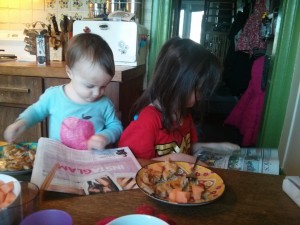 Pancakes: I don’t spend all my time avoiding my family, however. Every Sunday, I make whole-wheat banana pancakes from scratch, which sounds selfless and well-meaning until I explain that once the batter is mixed, I pull out what’s left of the Saturday paper, flipping the pancakes between articles. (“Go away. Mommy is cooking.”)
Pancakes: I don’t spend all my time avoiding my family, however. Every Sunday, I make whole-wheat banana pancakes from scratch, which sounds selfless and well-meaning until I explain that once the batter is mixed, I pull out what’s left of the Saturday paper, flipping the pancakes between articles. (“Go away. Mommy is cooking.”)
- But not at the table. Unless it’s breakfast or lunch…We don’t permit reading at the table at our house, because meals are a time for togetherness. We bend the rules for breakfast and lunch though, because bendy rules are useful for teaching flexibility. And because tables are so useful for having the Saturday paper spread across.
March 9, 2015
On Immunity by Eula Biss
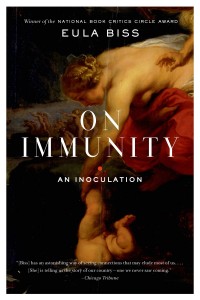 I will admit it: until recently, I was one of those parents whose children weren’t vaccinated due to my concerns about a number of toxic ingredients found in vaccines. But then when people started sharing vitriolic and expletive-filled Facebook statuses and tweets about “fucking anti-vaxxers” whose children deserved to die of smallpox, they really convinced me, and I finally came around and saw the error of my ways.
I will admit it: until recently, I was one of those parents whose children weren’t vaccinated due to my concerns about a number of toxic ingredients found in vaccines. But then when people started sharing vitriolic and expletive-filled Facebook statuses and tweets about “fucking anti-vaxxers” whose children deserved to die of smallpox, they really convinced me, and I finally came around and saw the error of my ways.
Okay, none of the above is true. First, because my children received their vaccines on schedule. But mostly because the described scenario doesn’t exist—no one’s going to change her mind in this climate. The rhetoric surrounding the vaccine “debate” is so inflamed and divisive that as it stands that there is no hope of reconciliation. I also have some sympathy for parents who doubt the safety or necessity of vaccines. While I have absolute trust in my doctor and her advice, and in the importance of vaccines for public health, I was one of the many people who put down that fear-mongering story in The Toronto Star last month on the HPV vaccine and said, “My kids are never going to get that.” And then the whole furor blew up, and I saw how we’d been played.
Which is the point at which I decided to read On Immunity by Eula Biss. Biss, poet and award-winning essayist, wades into the vaccine issue, not to seek a middle-ground—because she acknowledges that there isn’t one; the science is conclusive; her own child is vaccinated—but to seek context, to create something richer than a polemic. More than a book on “issues”, even, this is a book on language and metaphor, about how both frame the way we understand our bodies and our world, and about vaccinations and immunity might serve as a metaphor for America and the world today. “And it has vampires in it,” so notes the blurb on the back by Rebecca Solnit. Because, yes, this book is blurbed by Rebecca Solnit AND Anne Fadiman, which makes it basically a non-fiction holy book. And it is oh so very good.
Biss begins with the myths and fairytales, those stories in which “parents…have a maddening habit of getting tricked into making bad gambles with their children’s lives.” Including the myth of Achilles whose mother seeks his immortality. Biss writes, “Immunity is a myth, these stories suggest, and no mortal can ever be made invulnerable,” and considers the desperate ways in which parents seek to protect their children from their fates.
Her son was born as H1N1 panic spread across the world, around the same time my elder daughter was. I remember lining up for hours at Metro Hall downtown for the flu vaccines we were eligible for because we resided with a member of the vulnerable segment of the population. “It was not a good season for trust,” Biss writes, as financial markets were crumbling and many people were considering the response to the H1N1 panic to be overblown, a plot by big-pharma, the vaccine’s components considering dubious by many in the chattering-mother set.
Biss invokes Bram Stroker’s Dracula, a story that serves as a metaphor for disease. “What makes Dracula particularly terrifying, and what takes the plot of the story so long to resolve, is that he is a monster whose monstrosity is contagious.” And the story, she continues, is as much about the problem of evidence and truth as it is about vampires. How do we ever know what we know?
Public health, Biss notes, is rarely seen by members of the middle class as intended for “people like us.” She uses the example of prominent anti-vaccine campaigner Dr. Bob Sears who writes of the hep B vaccines, “This is an important vaccine from a public health standpoint, but it’s not as critical from an individual point of view.” Biss explains, “In order for this to make sense, one must believe that individuals are not part of the public.” But such a limited perspective is hardly novel, Biss shows shows, with historical epidemics thought to be the scourge of foreigners and outsiders (like Dracula!), and poor black people forced at gunpoint to be vaccinated in Kentucky a century ago. Historically, vaccination of those living in poverty would have benefited the wealthy, whereas the tables have now turned—the vaccination of children who live in privilege now serves to protect the vulnerable (in terms of income level and health). Biss extends her examination of this switch: “If it was meaningful for the poor [historically] to assert were not purely dangerous, I suspect it might be just as meaningful now for the rest of us to accept that we are not purely vulnerable. The middle class may be ‘threatened’, but we are still, just by virtue of having bodies, dangerous.”
But we feel threatened, we do. Here, Biss returns to poor season for trust, and explains how risk perception has more to do with fear than quantifiable risk. “Perhaps what matters,” Biss quotes the scholar Cass Sunstein has saying, “is not whether people are right on the facts but whether they are frightened.” And we certainly live in a culture of fear, which is ever heightened. Which has recently manifested in a paranoia against chemicals, countered with a strange faith that nature itself is benevolent. But vaccines, note Biss, reside where between the two: “vaccines are of that liminal place between humans and nature—a mowed field.” She further complicates the issue by using the example of the Americas’ native populations, decimated by disease after the arrival of Europeans: “Considering this course of events ‘natural’ favours the perspective of the people who subsequently colonized the land, but it fails to satisfy the ‘not made or caused by humankind’ definition of the term.”
Nothing is straightforward, and science writing, and misperceptions of science writing, skews things. Did you know that there is no causal link between DDT and cancers? I didn’t. I read Rachel Carson’s Silent Spring, her book that sparked a revolution by suggesting there is no boundary between the human body and its environment, and while this is indeed the case, and while spraying DDT from airplanes over towns and vast tracts of farmland is indeed dangerous and does irreparable damage to ecosystems, Silent Spring‘s greatest legacy, as noted by journalist Tina Rosenberg, is that it’s “killing African children because of its persistence in the public mind.” Malaria has resurged in countries where DDT is no longer used against mosquitos. While Carson recognized the utility of DDT for disease prevention, Biss writes, “the enduring power of her book owes less to its nuances than its capacity to induce horror…. Like the plot of Dracula, the drama of Silent Spring depends on emblematic oppositions.”
Biss traces the origins of vaccines to folk medicine, practiced by women until they were pushed out of their positions of power in their communities by the medical establishment (men who pushed women into unsanitary hospitals to have their babies, many of whom would die there because these doctors didn’t know to wash their hands). Biss notes the strange relationship between anti-vaccine mothers and vaccination itself, both born out of the same anti-establishment systems that seek/sought to undermine women and their intuitive knowledge vs. scientific fact. This is certainly not a story about emblematic oppositions after all. But still, not a reason to turn away from science altogether. We need science, notes Biss, via Donna Harraway. “Where it is not built on social domination, science can be liberating.”
My very favourite part of this book, whose every bit I appreciated so much, was the end-note to page 8 (and it’s a testament to the goodness of On Immunity that I read its notes in entirety. I didn’t want the book to end). Biss writes something that reads like an echo of my introduction to The M Word, about motherhood being one’s occupation and preoccupation in the early days, about all those conversations about motherhood between new mothers making sense of their world, which is also the world. And this is what I find so exciting about this book, that such a work of literature can be from those “productive and necessary” conversations.
Biss notes:
“These mothers helped me understand how expansive the questions raised by mothering really are… I am writing to and from the women who complicated the matter of immunization for me…In a culture that relishes pitting women against each other in ‘mommy wars,’ I feel compelled to leave some traces on the page of another kind of argument. This is a productive, necessary argument—an argument that does not reduce us, as the diminutive mommy implies, and does not resemble war.”
February 1, 2015
Wonder About Parents
 The weekend was unexpectedly quiet, all plans cancelled, and unexpectedly long. Thursday night delivered a stomach ailment that felled all of us, and meant we spent Friday lying down and eating popsicles while a brutal winter wind raged outside, and we didn’t really miss it. The children slept for hours after lunch that day, which meant I got to spend the afternoon reading in the tub—such an indulgence. On Friday night, we watched episode 3 of Broadchurch Season 2—we’re wholly riveted, even when it gets ridiculous—before finally getting a good night’s sleep after missing Thursday’s entirely. Saturday was a lot more lying down, and then we watched Gone Girl. This morning we were ambitious enough to go skating, which was wonderful, but it’s all still touch and go—we’re still only 20 hours since the last time anyone threw up. But other than the sickness and far too much laundry and really only eating bread and butter and saltines, it’s been kind of a nice weekend. There is nothing like being ill to make one appreciate feeling better, and nothing like being ill with 2 small sick children to make one appreciate a spouse who is a partner in every sense of the word—for better or for worse.
The weekend was unexpectedly quiet, all plans cancelled, and unexpectedly long. Thursday night delivered a stomach ailment that felled all of us, and meant we spent Friday lying down and eating popsicles while a brutal winter wind raged outside, and we didn’t really miss it. The children slept for hours after lunch that day, which meant I got to spend the afternoon reading in the tub—such an indulgence. On Friday night, we watched episode 3 of Broadchurch Season 2—we’re wholly riveted, even when it gets ridiculous—before finally getting a good night’s sleep after missing Thursday’s entirely. Saturday was a lot more lying down, and then we watched Gone Girl. This morning we were ambitious enough to go skating, which was wonderful, but it’s all still touch and go—we’re still only 20 hours since the last time anyone threw up. But other than the sickness and far too much laundry and really only eating bread and butter and saltines, it’s been kind of a nice weekend. There is nothing like being ill to make one appreciate feeling better, and nothing like being ill with 2 small sick children to make one appreciate a spouse who is a partner in every sense of the word—for better or for worse.
The whole thing made me think of the story “Wonder About Parents” from Alexander MacLeod’s collection, Light Lifting. It’s the story about lice, perhaps my favourite in the collection, the one I bring up whenever I’m recalling just how extraordinary that book is. That one scene with the father changing his sick baby’s diaper in the truck stop men’s room, the shit covered baby clothes he tosses into the garbage, and how his wife makes him go back in there and fish it out again. Because she likes that outfit, and it was a gift from her mother. That’s a moment so emblematic of the people parenthood turns us into, the absurdity of these situations. Those nights, those crises. We never think about them when we sign up for any of it.
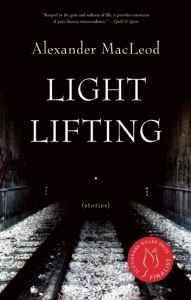 We could never have imagined. I was thinking about this on Thursday night as I lay in bed sleeping in five minute bursts, interrupted by Harriet throwing up downstairs, Stuart on the floor beside her bed, a pile of soiled sheets and blankets growing up in the corner. I could not sleep because I was hearing strange voices singing, every muscle in my body ached, because I kept having to get up and puke in a bucket, and because I was listening desperately for the sound of Harriet sleeping finally, but she wasn’t. (Her door downstairs just opened now, and its squeak has me wracked with anxiety.) Finally at 3am, I went down because I was finished being sick, and Stuart came up to get some sleep. I was awake until 5am beside Harriet but listening for Iris, who woke up then as usual, and then she was sick. And a new pile of soiled sheets was started in our room. By morning (or at least the part of it when the sun was up), we were all sleeping on top of beach towels, those of us who were sleeping at all.
We could never have imagined. I was thinking about this on Thursday night as I lay in bed sleeping in five minute bursts, interrupted by Harriet throwing up downstairs, Stuart on the floor beside her bed, a pile of soiled sheets and blankets growing up in the corner. I could not sleep because I was hearing strange voices singing, every muscle in my body ached, because I kept having to get up and puke in a bucket, and because I was listening desperately for the sound of Harriet sleeping finally, but she wasn’t. (Her door downstairs just opened now, and its squeak has me wracked with anxiety.) Finally at 3am, I went down because I was finished being sick, and Stuart came up to get some sleep. I was awake until 5am beside Harriet but listening for Iris, who woke up then as usual, and then she was sick. And a new pile of soiled sheets was started in our room. By morning (or at least the part of it when the sun was up), we were all sleeping on top of beach towels, those of us who were sleeping at all.
And it occurred to me at several moments throughout that night, that long long night during which the every passing hour brought a little relief because we were that much closer to morning, when I was holding on and holding my bucket as my child cried, thinking, “it really doesn’t get much worse than this.” It occurred to me it had been remarkable luck and not foresight that 12 years ago I’d met a boy on a dance floor who would become a man who’d take such care of our ailing daughter in the middle of the night, who’d spend the following day doing our laundry as I lay listless on the couch, even though he wasn’t feeling so hot himself. How do you ever, ever know? And what fortune that the whole thing worked out anyway. “You can’t tell anything in the beginning… Could go any number of ways.”
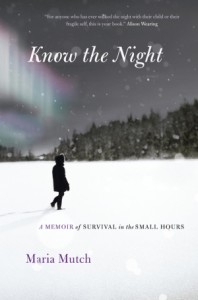 “The present tense. Everything happens here,” writes MacLeod in “Wonder About Parents,” and this is what makes the whole thing so mysterious, I think. How did we get from there to here? How did we become this people awash in a sea of vomit, these children wretchedly ill in a way I had no idea people could be ill (and now we even know it’s totally normal. We go through it a couple of times a year now)? If someone had told me about it, I would have speculated the whole thing was unsurvivable. One of oh so many things you think you could never get through, until you do. I am thinking of Maria Mutch’s Know the Night too, and how I never knew just how many minutes there were between midnight and morning until my children born, an unfathomable number. (In Mutch’s book, referring to her partner, she writes of “that ingredient vital for love, which can best be described, I think, as conspiracy,” which I think is part of what I’m getting at here.)
“The present tense. Everything happens here,” writes MacLeod in “Wonder About Parents,” and this is what makes the whole thing so mysterious, I think. How did we get from there to here? How did we become this people awash in a sea of vomit, these children wretchedly ill in a way I had no idea people could be ill (and now we even know it’s totally normal. We go through it a couple of times a year now)? If someone had told me about it, I would have speculated the whole thing was unsurvivable. One of oh so many things you think you could never get through, until you do. I am thinking of Maria Mutch’s Know the Night too, and how I never knew just how many minutes there were between midnight and morning until my children born, an unfathomable number. (In Mutch’s book, referring to her partner, she writes of “that ingredient vital for love, which can best be described, I think, as conspiracy,” which I think is part of what I’m getting at here.)
Everything was always the present tense, which makes it that much harder to understand how it turned into the past. Like the night, it always seemed to be an eternity until it wasn’t anymore. MacLeod writes, “The place where you wait for the next day to come.”
“We get to choose each other, but kids have no say about the nature of their own lives… What are we to these people? Genetics. A story they make up about themselves.” –from “Wonder About Parents”
“Wonder About Parents” is a story whose workings are fascinating, and I would like to write about it in a more in-depth way when I’m not recovering from illness and the loss of 1.5 nights of sleep. Though I also suspect it’s a story whose wonders are mostly firmly grasped from my current state of mind, if not wholly articulated. The story begins with a couple picking nits from another’s heads, their household under siege. “It’s the third week”. There is so much laundry. “Can’t go on forever./ No.”
The fiction is part entomological investigation of the mighty louse. “The history of the world indexed to the life of an insect.” The parasitic relationship between louse and human is vaguely connected to the parent/child relationship, something persistent in the sheer determination of louse to be, related to that of the human, of the human’s drive to reproduce. The force of life also bringing with it death—typhus is transmitted by lice, MacLeod’s narrator tells us, and killed 30 million people after WW1. And then a scene with the family lining up to be inoculated for swine flu, all that hysteria, fights in the line-ups that started at 4 in the morning. What we do for our children, the ridiculous scenarios. How fragile is our safety, but still we all go forth.
And then before the children, achronological, but all still present tense, and fertility struggles. You never do imagine the care with which you might end up examining your vaginal mucous, all for the eventual outcome of sailing on a sea of vomit, tucked into bed beside your finally-sleeping child wishing that you hadn’t bought her a $45 foam mattress (though the vomit would ruin it anyway, so perhaps it was all for the best).
“Desired outcomes. What we want is when we want it. No way to connect where we are and where we were. This is the opposite of everything we’ve ever done before.”
There are the worst nights, hospital visits with babies a bundle in your arms. A reference to the DDT that solved typhus, but dug its way deep into the food chain before anybody noticed. Causing infertility, cancer, miscarriages. “But life adapt. They go on. Become resistant. Completely unaffected by DDT now. Not like us. Trace amounts of it in every person’s blood.”
The baby has kidney disease, “a congenital abnormality.” We’ve seen this girl already in the shower receiving her lice treatment: “A scar on our daughter’s stomach from before.” So we know which way this story will go. But MacLeod leaves us here, in the hospital, the couple only four months into parenthood, and already they’ve entered its darkest places. And how they lean on each other, how they need one another. They are everyone they’ve ever been, squeezed together in an uncomfortable vinyl chair. Wedded to all of human history.
“Darkness in the room. Our baby makes no sound. Only the bulb from the machine now. Inscrutable purple light flashing on the ceiling. Like a discotheque, maybe, or the reflection of an ancient fire in a cave.”
September 29, 2014
May Friedman on Mommyblogs and uncertainty as a valuable critical end
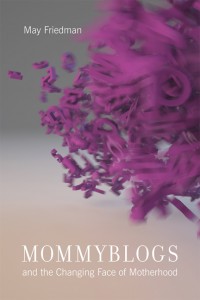 “In trying to form conclusions about mommybloggers—and about mothers—I am reminded of my children attempting to jump upon their own shadows: I am attempting to trap an essentially untrappable form of knowledge. After the initial discomfort and frustration that this inconclusive conclusion elicits, however, I have found that there is much to gained, as a researcher in general and as a motherhood researcher in particular, in looking instead at uncertainty as a valuable critical lens.” –May Friedman, Introduction, Mommyblogs and the Changing Face of Motherhood
“In trying to form conclusions about mommybloggers—and about mothers—I am reminded of my children attempting to jump upon their own shadows: I am attempting to trap an essentially untrappable form of knowledge. After the initial discomfort and frustration that this inconclusive conclusion elicits, however, I have found that there is much to gained, as a researcher in general and as a motherhood researcher in particular, in looking instead at uncertainty as a valuable critical lens.” –May Friedman, Introduction, Mommyblogs and the Changing Face of Motherhood
This is a kind of criticism that does not pit the critic against the text, does not seek authority. It seeks instead to travel with the work and its ideas, invite it to blossom and invite others into a conversation that might have previously seemed impenetrable, to draw out relationships that might have been unseen and open doors that might have been locked.” —Rebecca Solnit, “Woolf’s Darkness: Embracing the Inexplicable”
It pains me to link to this smug and stupid post I wrote in May 2009, just 11 days before my first child was born. When I purported to understand anything in Rachel Cusk’s A Life’s Work, because I really didn’t. And when I tried to pin down mommybloggers, detailing my discomfort with the form, and my discomfort with that discomfort. I thought I had it all sewed up, because I was surer of things then, and I had no idea of the seas of uncertainty I’d be wading into when it came to mothering, motherhood, and issues around motherhood. Five years later, The M Word was to be partly my means of coming to terms with the beauty of the mess of it all—when in doubt, make an anthology.
When, three months after that embarrassing 2009 blog post, I reviewed the book Mothering and Blogging: The Radical Act of the Mommy Blog by May Friedman and Shana Calixte, my thinking had evolved somewhat, but I was still pretty stupid. (This is the curse of any blogger: you are forever presented with undeniable evidence that you were pretty stupid. And that mostly likely you still are.) But I was getting a sense of things—that motherhood and any ideas surrounding motherhood refused to stay put in my tidy pat conclusions, and that there were many women who didn’t want even them to.
May Friedman’s new book, Mommyblogs and the Changing Face of Motherhood, occurs at a pivotal intersection in my writing life. Outside of my blog, it is my writing about motherhood and my mothering life that has found most resonance with readers, so much so that when a recent published story contained nary a reference to mothers anywhere, I was a bit relieved. And I’ve also been blogging for 14 years this October, which has led to the opportunity to teach the course, The Art of Blogging, at the University of Toronto (whose latest session starts a week from tonight!). In my blog teaching, I embrace and celebrate the messy chaos of the blog form, as unpindownable as mothers are. (You can read my posts with thoughts on blogging here.) I welcomed the reflections, revelations and insights of Mommyblogs and the Changing Face of Motherhood not just for what they had to say about mothers and mommyblogs, but for the perspective the book provided on the history and implications of the blogosphere with a lens on women (who, as in any history, are so often left out of the story).
True confession: I have an allergy to Foucault, and once they start referencing Bahktin, they’ve already lost me. As an academic text, Friedman’s book stands apart from others that I’ve encountered in that her critical framework serves to transform the familiar into something altogether new, rather than rendering it intelligible. In Mommyblogs and the Changing Face of Motherhood, she examines mommyblogs in the frameworks of hybridity (as a form, of the identities of blog authors, of the experiences of readers), cyborgs (of the author and her text via technology, and also of the complex and nuanced networks created through blogging communities, how mothering is reworked away from being an individuated task) and Queer theory (a movement away from the patriarchal institution of motherhood toward an otherness) to show that mommyblogging is indeed a radical act that has already changed the way motherhood is regarded in the public sphere, and whose further implications are still before us, rich with possibility.
It is as applicable to that mythic blogosphere as a whole what Friedman has to say about “the mamasphere”: “It is precisely because it is impossible to say anything generalizable about the mamasphere as a whole that it is a radical maternal space; not as a result of the activism of individual mothers, but because of the implications of all these narratives coexisting, and the endless unspooling dialogue that therefore emerges.” That lack of generalization doesn’t freak me out anymore, and I appreciate Friedman’s excellent book for reminding me why certainty is anathema to everything I like best about the world, both online and off.
See also: “Mary Pratt, On Blogging, and Preserving Light and Time”
August 12, 2014
Summer of the Yellow Dress
In most of our photos from this summer so far, a memorable (much) recurring character has been my yellow polkadot dress, which is one of the few things I own that always garners compliments from strangers. I bought the dress at a secondhand store at the end of May, which was surprising because I’m sort of between bodies right now and clothing is an awkward fit. So it was shocking to encounter this Donna Karan shift dress for $30, and then the yellow polkadot dress for $20, which I can even breastfeed in if I’m unabashed about having my boobs out.
The yellow dress was a strange purchase for me–I’ve never worn anything yellow before. I am very much partial to red and blacks, to fuchsia if I’m feeling like some colour. But the yellow dress appealed to me because it looked like something Harriet would wear. Yellow is her favourite colour, and she’s zealously devoted to it, still, even though she has recently consented to be served dinner on a plate that is another colour (if necessary). When I wear yellow, I look even more sallow than I actually am, so I’ve always avoided it, while celebrating Harriet’s affinity for it. Hooray for a little girl whose favourite colour is anything but pink.
But this dress… “What would Harriet do?” I wondered. Obviously, she would buy it, and insist on wearing it to bed, and while I didn’t go that far, I bought it and even put it on. “What do you think?” I asked my family, and they loved it. It’s kind of a weird dress with a ruffly colour, one that’s meant to be worn off the shoulder, I think, but I don’t do that because I am not a 1970s’ bridesmaid. It’s a wee bit too tight (but what isn’t these days) but the cut is flattering. And it turns out that I look not so terrible in yellow after all, or at least not once summer has arrived and the sunshine has kissed my face a bit.
And it’s a lesson I think, as well as a fortunate fashion tale (because it could well have gone the other way). That I can learn a little something by taking a leap and seeing the world through Harriet’s eyes. That something might be gained by aspiring to be just a little more like she is.
I am thinking of taking up her practice of lying on the sidewalk and screaming and kicking whenever I’m hungry or tired…
May 15, 2014
The M Word: What Motherhood Taught Me About My Abortion
And here it is! My essay from The M Word appears on The Huffington Post Canada, and I’m so relieved and bolstered by the feedback I’m receiving. Hope you will enjoy reading it.
April 28, 2014
My Co-Workers in the Mother Trade
“Just when I most needed important conversation, a sniff of the man-wide world, that is, at least one brainy companion who could translate my friendly language into his tongue of undying carnal love, I was forced to lounge in our neighbourhood park, surrounded by children.
All the children were there. Among the trees, in the arms of statues, toes in the grass, they hopped in and our of dog shit and dug tunnels into mole holes. Wherever the children, their mothers stopped to talk.” –Grace Paley, “Faith in a Tree”
I live a long way from Grace Paley’s Washington Square Park, Ms. Faith Darwin up in a tree. Paley’s fictional Faith and her scrappy friends talking politics and gossip as their children misbehave in the playground. These other women whom Paley (as Faith) calls, “My co-workers in the mother trade.” And I love that idea, the necessary solidarity even while personal alliances can be complicated. I think some of us could go a long way toward sorting out these Mommy wars (which are mostly fictional anyway) if we looked upon our fellow mothers like this. If our approach could be this un-adversarial, acknowledging the trade element of it, that motherhood is work and struggle, and yet in comradeship, our solidarity, the burden of it all is less. In our comradeship, there is even pleasure. The whole idea makes me long for a tree to perch in, for my very own corner in Washington Square Park.
But I kind of have that corner, I really do.
You know, Mom-friends get a terrible rap. I know this partly because I’ve done the rapping, acknowledging the disappointment and loneliness of my early days of motherhood, how I used to wander playgrounds desperate for someone to talk to as I spent my days caring for a nonverbal baby-person. I used to go to Mother/Baby yoga and not talk to anybody, and instead, measure myself agains all the women whose hair was styled, whose abdomens didn’t resemble deflated tires, the women who seemed to know exactly what they were doing, where I’d never been so inept in my life.
But that was a long time ago. (And what I’d give for an deflated tire abdomen these days, living as I do with its pneumatic cousin…)
Harriet began (pre)schooling about 18 months ago at a cooperative play school (speaking of comrades). I was nervous. “Other moms,” I thought, wrinkling my nose and thinking about yoga. But immediately, things were different. Part of it was the school itself, I think, which is part of a really excellent community. There is an atmosphere of friendliness fostered among the children, and that atmosphere makes its way up to their parents too. I remember during Harriet’s first few weeks at the school, I’d arrive to pick her up in the playground, and I soon found myself invited into the other mothers’ conversation. It got to the point where on sunny days, we’d linger in the park for hours, burying our feet in the warm warm sand, the children happily playing while I chatted with their moms.
Last year when I was pregnant, the other mothers celebrated my pregnancy alongside me and commiserated about its trials. When I was having health concerns (the kind that left me bursting into tears when other moms asked how I was doing), the support I received from these women buoyed my spirits. When Iris was born, other moms picked Harriet up from school, kept her for afternoons, and were incredibly generous with gifts that made her feel special. Because of the playschool moms, our family is part of a community that ties us to our neighbourhood and to this city. With the playschool moms, I’ve had the most important conversations.
(Sometimes, the playschool moms are dads, though not often. They’re sometime nannies too. And the playschool moms work part-time, full-time, work from home, work at home. There are a million ways to do it.)
It’s not just playschool though, because Harriet started kindergarten this year and it’s been just the same. I drop her off in the mornings and meet up with moms and dads starting out on their own days, and they’re always friendly and kind. In the first few weeks of school when Harriet cried every morning and then when I eventually left her, I’d be crying too, they were all so nice to me, so supportive of the tearful woman with the new baby whose big kid was a basket-case. Those who’d been through it already told me everything would be fine, and they weren’t lying. I meet them these days, on the other side of winter, and can’t quite believe how far we’ve come. Our conversations tend towards small talk, but these connections are vital. I know these people, I like these people. I know their kids, I’d trust them with my own kid, and I know that if I needed help, I wouldn’t be alone.
These are not friendships exactly. Maybe some of them will grow to be, but the collegiality in Grace Paley’s phrase is precisely right. These are my co-workers in the mother trade, we’ve all come so far since baby yoga, since we were desperate and tired and had something to prove. At kindergarten drop off at 8:57 Monday morning, never is there anything ever to prove, except that we made it before the bell rang, and that is huge and that is awesome. A victory we all share in. It’s a lovely way to start a day.
April 1, 2014
They just happened to be standing nearby
“Strictly speaking…. this book is not about [my children]; they just happened to be standing nearby while I looked for illumination, and so they cast their moving shadows.”
March 5, 2014
It Was Not What I Expected by Val Teal
 We’ve had The Little Woman Wanted Noise out of the library, a picture book by Val Teal and illustrated by Robert Lawson, recently reissued by New York Review Books. Lawson is notable as the illustrator of The Story of Ferdinand and Mr. Popper’s Penguins, though it was Val Teal’s biography that most intrigued me. “In addition to her stories for children,” it reads, “Teal also wrote a memoir of motherhood, It Was Not What I Expected.”
We’ve had The Little Woman Wanted Noise out of the library, a picture book by Val Teal and illustrated by Robert Lawson, recently reissued by New York Review Books. Lawson is notable as the illustrator of The Story of Ferdinand and Mr. Popper’s Penguins, though it was Val Teal’s biography that most intrigued me. “In addition to her stories for children,” it reads, “Teal also wrote a memoir of motherhood, It Was Not What I Expected.”
It Was Not What I Expected is described in this 1948 review as “[s]teering away from sentimentality… a vivacious, gaily turned account of modern parenthood.” I liked the sound of that, as well as any parenting memoir by the author of The Women Wanted Noise, who in her dedication thanks her own three sons, “whose noise inspires the little woman.” The book isn’t easy to come by, long out of print and not held by local libraries, but used copies are available on Abebooks (though that I bought the cheapest I regret now, because it came without a dust jacket).
 I had some ideas of what an account of modern parenthood published in 1948 might read like. I had these ideas because a long time ago I’d read Dream Babies: Childcare Advice from John Locke to Gina Ford by Christina Hardyment, which is where I first encountered the idea of babies being aired from apartment buildings in cages. It is also where it was first made clear to me that childcare advice (and “parenting philosophies,” baby fads and gadgets, and dictums everyone from Ferber to Sears) is a complete load of bollocks, and that we ought to cleanse our minds of most of it, except for reasons involving amusement or historical interest. The more things change, the more they stay the same, which is both a cliche, and also Hardyment’s thesis and in this context, such a revelation.
I had some ideas of what an account of modern parenthood published in 1948 might read like. I had these ideas because a long time ago I’d read Dream Babies: Childcare Advice from John Locke to Gina Ford by Christina Hardyment, which is where I first encountered the idea of babies being aired from apartment buildings in cages. It is also where it was first made clear to me that childcare advice (and “parenting philosophies,” baby fads and gadgets, and dictums everyone from Ferber to Sears) is a complete load of bollocks, and that we ought to cleanse our minds of most of it, except for reasons involving amusement or historical interest. The more things change, the more they stay the same, which is both a cliche, and also Hardyment’s thesis and in this context, such a revelation.
For example, here is Val Teal on big strollers, which remain, of course, a contentious issue to this day:
“In those days buggies were built. None of your light canvas affairs. They had a solid steel framework and lots of it. They had a big wicker body and hood with a steel bottom with a diaper compartment large enough to hold a dozen or so. The baby-carriage manufacturers expected you to push the baby on really long trips. If you took the notion to walk to Chicago some afternoon to visit your aunt they would not stand in your way. They had prepared a perambulator with ample space for the baby’s and your luggage during your stay. They expected you to have a big baby and push him around until he was three or four years old and they had provided room for this, with enough left over to bring home the groceries, including a watermelon if you were so inclined. The buggy weighed several hundred pounds, several hundred and fifty pounds with the baby and his paraphernalia aboard. We did not have an extra garage to keep it in. It furnished our small dining room very nicely before we could afford a dining room set. While you pushed this young truck around like mad, your tongue hanging out the baby sat like a rosy king, taking in the world with his round eyes, the air with his pink nose.”
 It is often said that nobody tells the truth about motherhood, though I think the reality is really that nobody ever listens. Because Val Teal was telling the truth in 1948, Betty Friedan in 1963 Erma Bombeck in the 1970s, Susan Swan in 1992, just to pick a handful of examples. Some early passages from It Was Not What I Expected were so similar to my own experiences, which had come as such a surprise to me when my first baby was born. Like this one, as Teal and her husband arrive at the hospital for their first baby’s arrival:
It is often said that nobody tells the truth about motherhood, though I think the reality is really that nobody ever listens. Because Val Teal was telling the truth in 1948, Betty Friedan in 1963 Erma Bombeck in the 1970s, Susan Swan in 1992, just to pick a handful of examples. Some early passages from It Was Not What I Expected were so similar to my own experiences, which had come as such a surprise to me when my first baby was born. Like this one, as Teal and her husband arrive at the hospital for their first baby’s arrival:
“Across the street a young couple were just getting home. They were laughing and talking softly as he found the key and put it in the door. We could have been just like that as well as not. We could have been just coming home from a party. Why had I been so eager? Maybe I’d die. Maybe we’d never come home from a party like that again together… We had been so happy. We’d had a good life. Why had I had to get ambitious? Darn it all, I didn’t want a baby. I just wanted to go home and go to parties.”
A few pages later, the baby is born, and mother and son are home:
“The Baby cried and cried. I had given up not feeding him at two in the morning long ago. Every time I fed him he went to sleep for half an hour. Then he cried again.
‘I didn’t know it would be like this,’ I wept to Bill. ‘I wish I was back in the hospital.'”
 Motherhood was less complicated for previous generations, Teal explains. She describes a trip when her first son was seven months old, the directions they’d had to send ahead, provisions required, their car ridiculously packed. Along they way, they stop for the baby’s sunbath (as dictated by both government pamphlets and the Women’s Home Companion). She writes, “I used to think about [my mother] being cleaned up every afternoon, baking cakes for visitors, sprinting off peppy as a kitten to coffee parties, pushing her baby-sled full of clean babies, and I wished I’d lived then when babies were less complicated…”
Motherhood was less complicated for previous generations, Teal explains. She describes a trip when her first son was seven months old, the directions they’d had to send ahead, provisions required, their car ridiculously packed. Along they way, they stop for the baby’s sunbath (as dictated by both government pamphlets and the Women’s Home Companion). She writes, “I used to think about [my mother] being cleaned up every afternoon, baking cakes for visitors, sprinting off peppy as a kitten to coffee parties, pushing her baby-sled full of clean babies, and I wished I’d lived then when babies were less complicated…”
It Was Not What I Expected takes great joy in dissecting the naiveté of the new mother, insistent upon raising baby according to the book (what book? depends which decade, I suppose). How stupid we all were in those early days, and how determined we were that we would be the masters of motherhood rather than motherhood be the masters of us. Naturally, hilarity ensues.
Memorable scenes include Teal getting locked in the attic while her son sits outside the door eating beads, and the time she hires a simple-minded creature prone to seizures to babysit as she tries to better herself at a meeting of the American Association of University Women and it all goes wrong. (“I began gradually to give up the International Relations section because Hitler seemed to go right ahead doing impolite and smarty things, even though we met every week with luncheons too, instead of teas.)
And like any mother, she frets about play dates:
“I learned at the Child Study Group that children need companionship. If you child did not have others to play with you must do something about it. You must see that other children came to your house. It was a matter of life and death. Or anyway the difference between success and failure. You must drag in companionship. You must inveigle children to come. You must offer them food and toys, anything, to get them there. Companionship was the breath of life to the normal child.”
Teal’s second child just escapes being born in the Piggly Wiggly. “Now I knew all about babies,” she writes. “Peter would be easy to raise. I was experienced. There would be no foolishness about who was boss. I knew who was boss.” Instead of books to raise this baby, she decides, she’ll employ her own instinct. She will let the baby do what he likes.
 More adventures in motherhood with boys: the necessary acquisition of a menagerie, dogs, ducks and rabbits. The obligatory paper-route. She helicopter parents, terrified of her boys riding their bicycles and therefore driving along behind them in the car on the way to their music lessons.
More adventures in motherhood with boys: the necessary acquisition of a menagerie, dogs, ducks and rabbits. The obligatory paper-route. She helicopter parents, terrified of her boys riding their bicycles and therefore driving along behind them in the car on the way to their music lessons.
She addresses her determination that her boys shall play with dolls, much to the concern of everyone around her. To which she replies, pre-dating Charlotte Zolotow, “If more boys had been allowed to play with doll there’d be more intelligent fathers. Boys have been taught for too long a time that it is shameful for men to have anything to do with the care and bringing up of children. Men need tenderizing. I’m going to raise them to, first of all, be kind and loving fathers, and considerate husbands.” This chapter is wonderful, and ends with her son packing his doll (Uncle Pat Mulligan), along with a toy revolver on a trip:
“What have you got that for?” I asked. “Leave [the gun] at home. You’ve got enough to carry.”
“No, I gotta have it,” Peter grabbed for the gun.
“What for?” I asked, holding it back.
“If Pat Mulligan turns bad on this trip I’ll have to shoot him in the stomach,” Peter said.
I gave Peter the gun. You never could tell when Pat Mulligan might turn bad.
 Teal’s picture book and her memoir are excellent companions. In the former, the little woman cannot rest without noise and goes out of her way to acquire more and more animals to liven up her farm and fill the air with sound. With that same lust for more, Teal writes in her memoir of her own yearning for a large family, a yearning augmented by a miscarriage and a stillbirth. “What no man, no doctor, no woman who has never lost a child can ever know about, is the consuming desire to replace that child that comes to the woman who has lost one.” The losses are not dwelt on here, but neither are they swept under a rug, instead acknowledged in practical terms as part of the vast motherhood experience.
Teal’s picture book and her memoir are excellent companions. In the former, the little woman cannot rest without noise and goes out of her way to acquire more and more animals to liven up her farm and fill the air with sound. With that same lust for more, Teal writes in her memoir of her own yearning for a large family, a yearning augmented by a miscarriage and a stillbirth. “What no man, no doctor, no woman who has never lost a child can ever know about, is the consuming desire to replace that child that comes to the woman who has lost one.” The losses are not dwelt on here, but neither are they swept under a rug, instead acknowledged in practical terms as part of the vast motherhood experience.
Teal’s narrative is remarkable for its blend of wry humour and depth, of exasperation and joy. She so perfectly articulates motherhood as the curious mix that it is of the spiritual and earthly, the perfect and perfectly awful:
“Sometimes I’d look down and see these children around the house and feel very surprised and young and incapable… My goodness, where had they come from?… How in the world had this come about all of a sudden? They weren’t dolls, dream-figures. They were real, alive children, going-to-be men; dear Heaven, what had I done? I had made people! I had made people, Lord help me, people with emotions and plans and wishes and disappointments and longings. People. With souls. And when it would come over me, I’d stand very still and get very scared and helpless feeling. But they always brought me out of it.”
January 27, 2014
Two Posts for Family Literacy Day
January 27 is Family Literacy Day, an excellent initiative by ABC Life Literacy Canada to promote the importance of families taking part in reading activities together. And because this is pretty much my favourite time of year, I’ve been busy writing Family Literacy Day-related things.
For Today’s Parent, I wrote “The Secret to Raising Readers.” Here’s a hint: it involves Trollope castles, letting your children eat their books and then throw them on the floor.
And at 49thShelf, I wrote about why I censor our family’s bedtime reading. (Why? Because family literacy is not just about the kids.)
May all your story-times be fun, and your picture books be brilliant.

